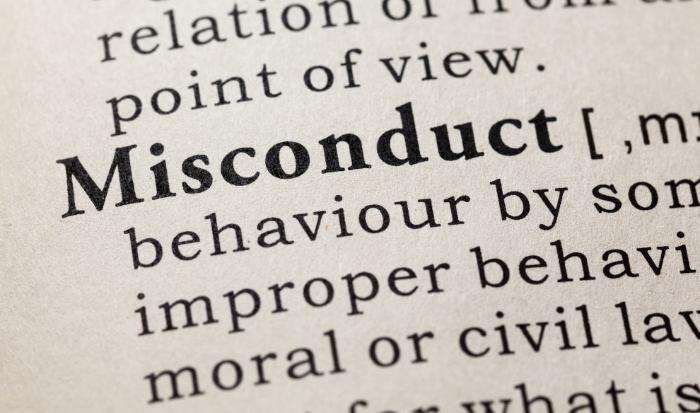Final written warnings are part of a broader disciplinary process that must be completely understood and adhered to as a business owner. In other words, if you’re about to issue a final written warning and (possibly) terminate an employee’s contract at the end of their review period, then you need to ensure it is a fair process. Failure to do so could mean your employee’s dismissal is seen as unfair, which could be very damaging to your business if the disciplinary action was brought under review at an employment tribunal.
A final warning can usually be given when you, as the employer, feel an employee’s behaviour is poor conduct, or reflects an inability to effectively complete their responsibilities ascribed to them in their job role. Final warnings may be given to prevent offending behaviour, or where employee’s have continually failed to meet specific workplace targets relating to their role over a set period.
Essentially, if your employee isn’t behaving in an appropriate manner (or is even behaving in a way that constitutes gross misconduct), or they are failing to meet expectations for their job role (and there aren’t any obvious mitigating circumstances to help explain their change in behaviour or failure to meet work related targets) then you’ll likely be left with no choice but to issue a final written warning. But in order for it to be considered fair, you’ll need to ensure you do so at an appropriate time and in an appropriate way.
Let our ultimate employer’s guide take you through how and when to issue a final written warning below.
Table of Contents
What Is A Final Written Warning?
A final written warning is issued in the most extreme cases of employee misconduct or where an employee refuses to complete their job role to an expected level. It sets out in writing the issue you, as an employer, have with your employee’s behaviour at (or related to) the workplace, and warns them that the consequences of continuing to replicate said behaviour will likely lead to dismissal. Essentially, it’s a last chance letter that lets the employee know that they’re on their final warning, and further poor behaviour will lead to a termination of the employee’s contract.
The final written warning will also usually include a timescale in which a change in behaviour or improvement in performance must be seen – failure to meet these expectations will lead to termination.
Final written warnings can occur at any time during employment, and may follow a first warning, series of warnings, or may, in fact, be a first and final written warning – it all depends on the allegations made against the employee and the seriousness of them.
Written warnings of this nature can only be given following a full and fair investigation into the matter.
What Do Final Warnings Mean For Employees?
A final written warning for an employee means they are at risk of losing their job if they don’t change their behaviour. It puts them on notice of the potential consequences of their poor behaviour and gives them the chance to change accordingly to meet the expectations and targets set out for them.
Any employee given a final warning will know that their behaviour will be monitored for the time being, especially closely, and they’ll be given a specific timeframe in which to improve their workplace conduct.
It’s important to note that the timeframe given to the employee to turn their behaviour around and improve their chances of retaining their job must be reasonable.
At the date given as a deadline, a review will then take place and your employee will either prove they have taken their final warning on board and changed, or you will be left with no choice but to terminate their contract. The key here is fair warning and ample opportunity for the employee to correct their behaviour in line with expectations and workplace policies.
In What Circumstances Should A Final Warning Be Used?
There are two main scenarios in which a final warning is usually appropriate:
| Reason for final warning | Explanation |
| As a last resort | A proper and proportionate disciplinary process must be followed in all workplaces when allegations of workplace misconduct or a lack of capability to effectively complete their job role is made against an employee. Other avenues should be explored before reaching straight for a final warning, but there may be instances where a first and final written warning is appropriate. |
| First and final | Where workplace misconduct is so severe, a final warning may be appropriate and proportionate depending on what allegations are being made against the employee. If a young person feels threatened by an action taken by a more senior employee at your business, for example, and the offensive behaviour is proved true following a full and fair investigation, but that behaviour doesn’t constitute offending behaviour in the eyes of the police, then you might turn to a final written warning as a deterrent to prevent future similar behaviour. |
These are key examples of where a final warning might be given, but when should you consider issuing one to your own employee? It can feel like an uphill legal battle, but so long as you follow certain key steps, you’ll know your action in putting your employee on a written warning is completely fair, appropriate, and proportionate.
When To Issue A Final Written Warning
The whole point of a final warning is to impress upon your employee the seriousness of their conduct or capability issues. As such, it needs to be handled professionally. We’ll talk you through how to handle delivering a final written warning later, but for now, there are three main things you need to be prepared before any disciplinary action is taken.
Follow Your Company’s Disciplinary Policies
The first thing to consider is your own company’s disciplinary policies. Whatever issue you have with your employee – whether that’s conduct related or concern regarding their ability to perform effectively – you must be able to point to the workplace policy that they aren’t living up to.
Depending on the disciplinary issue, you may have to go through several disciplinary processes before you even reach a final warning. For example, timekeeping may be the issue if your employee is always late for work. It would be reasonable to first talk about this with them in an informal setting, and then if the issue continued, you might result to an official verbal warning, a series of further verbal warnings, a written warning, and then a final written warning if the issue persists. Look at your own disciplinary policies (as they’ll be different from business to business) and ensure any action you take is reasonable.
Consider The Reason For The Warning
In order to act reasonably, you’ll need to consider the reason for the warning.
In the most extreme cases your employee might act in a way towards a member of staff or a member of the public that means a final written warning is an appropriate response immediately in order to correct their behaviour.
In most cases, however, a number of disciplinary actions will usually have taken place prior to a final warning to give your employee the best chance of redeeming themselves, taking responsibility, and acting in a way you would expect at your business.
Consider each case individually, and respond accordingly.
Full And Fair Investigation
The best way to carefully consider the allegations is to conduct a full and fair investigation into the matter. We’ll walk you through how to do that in a later section, but just remember a thorough investigation is always necessary. Never jump to conclusions or you might end up in legal bother as a business.

Following The Correct Legal Processes
In order to ensure you avoid legal repercussions as a business owner, following the legal processes surrounding final warnings in the workplace correctly is vital.
Prior to a warning these legal obligations include:
- A thorough investigation before issuing any warning.
- Providing your employee the right to respond to the allegations during a disciplinary hearing.
- Providing a right to appeal should a final warning be deemed necessary.
Following the decision to give your employee a final written warning, these legal obligations include:
- A letter setting out a clear explanation of what being on a final warning means.
- Setting out, in clear writing that your employee understands (other languages may be necessary here if your employee would understand the information better in another language), what’s expected of them during the review period.
- Making clear, in writing, how long they will be under review for, and when a final hearing on the matter is likely to take place.
- Explaining, in writing, their clear, achievable targets for improvement.
- An explanation, in writing, of how you as a business will be supporting them to meet those targets during the specified timeframe.
- Documenting all decision-making by senior management at each stage to ensure the proper disciplinary and legal processes have been followed.
What Is The Fairest Way To Issue A Final Written Warning?
Now that all of that is clear, let’s breakdown, step-by-step, the fairest way to issue a final written warning to ensure your business is meeting its end of the bargain when assessing and reviewing your employee’s conduct or capabilities.
1. Start With The Facts
Before any disciplinary action is taken, you must establish the facts. If a complaint is made by another employee, management, or member of the public, or capability concerns are raised during a performance review, you must first speak to all relevant parties to ensure you understand exactly what has happened. Only then can you move forward with confidence.
2. Stick To Company Policies
Next, consult your company policies. Ensure the disciplinary processes set out in those policies are adhered to.
3. Consult Legal Guidance
Always look at the legal issues surrounding final warnings at work and consult with workplace lawyers if you feel it necessary.
4. Provide Notice To The Employee
If it is agreed upon that a final written warning may be necessary, you must provide notice, in writing, to the employee to let them know that there conduct or capability is under review, and disciplinary action may take place, potentially leading to a final written warning, following a full review. Make clear the reasons for the review into their behaviour.
5. Set Out The Disciplinary Process
In the written notice, you should also include the stages of the disciplinary process that will now follow. Let them know what each stage is, and when it is likely to be completed by, as well as informing your employee of their expected behaviour during this time.
6. Conduct A Disciplinary Hearing
The key stage of any final warning is the disciplinary hearing. Your employee MUST be given the right to respond to the allegations being made, and you must share with them the evidence you have collected to indicate why a final warning may be necessary. It is their legal right to respond.

7. Allow For An Appeal
At the conclusion of the hearing you must let your employee know that, whatever the outcome, they have a legal right to appeal any decision made.
8. Make Your Final Decision
Now that you have all the facts and have heard from your employee, you can make your final decision. It may be that no final written warning is necessary. If you have deemed it necessary, however, make sure you stick to your company policy and ensure it is consistent with the approach your business has taken with similar cases in the past.
9. (Bonus) Create An Action Plan
Where a final warning is necessary, now is the time to set out an action plan. Work with the employee to set out realistic and reasonable targets for them, to help them demonstrate how their conduct or capability can be shown to have improved. This could be anything from counselling to workplace mentoring, a change in responsibility or reassignment to a new team. Set out how the business will help them achieve these targets. Ensure both parties agree.
10. (Bonus) Review Progress
Make clear when a final progress review will take place, and then during this meeting be prepared to share with the employee whether the business feels they have succeeded or not in turning their behaviour around. If they have, then the final warning will be removed and the employee will usually be placed on a probation period to monitor their continued success. If they haven’t, dismissal is usually the next and final stage.
Summary
The key to issuing a fair final written warning is sticking to your company’s policy, gathering as much information about the accusation as possible, conducting a full and fair investigation into the matter, and keeping the employee informed at every stage. Get this right, and you’ll almost certainly make the right decision for your business.
Issuing a final warning is a huge decision, so make sure you follow the correct legal and disciplinary processes outlined in the article above, to avoid any complaints from your employee in the future and any legal repercussions of failing to meet your business’ own disciplinary and legal obligations.





















































































































































